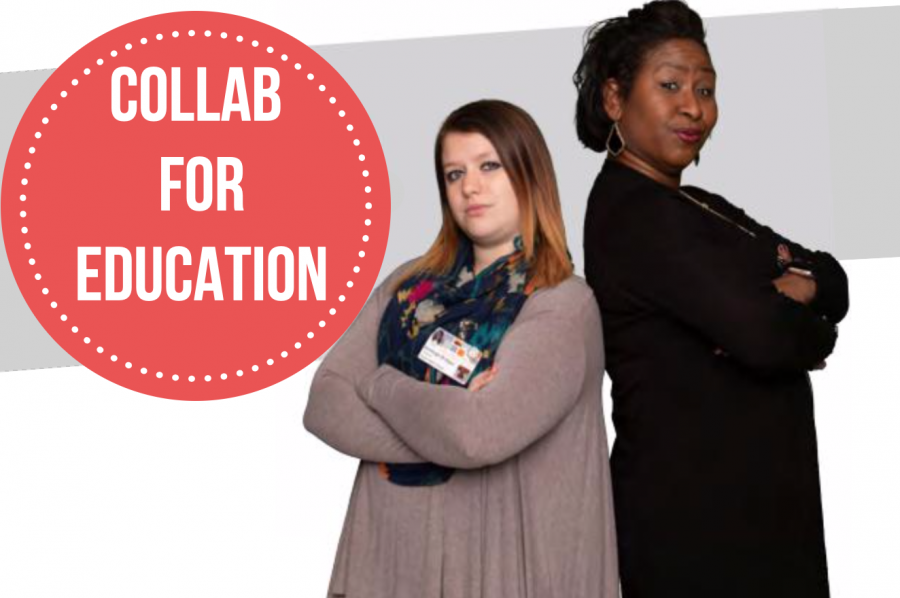Collaboration for education
Co-teaching improves inclusion among students, special education
November 18, 2018
Photo by Bailey Groom
When it comes to special education, students in need of instructional aid often struggle in typical scholastic settings. From social constraints to personal rates of comprehension, the attention they require is often a task much too formidable for one teacher alone to handle. What these students need is similar to what is instilled within any corresponding system of governance: a division of attention–a special approach.
Special education is a distinct experience for each student involved, whether it be physically or psychologically. The resulting sentiment can be one of isolation and confinement, where alienation abounds as a result of basic necessity. Special education blurs the lines between a school with special-education services and that of one which offers a normal, teenage experience for all students, despite special circumstances. Collaborative teaching is a weapon designed to sever this sense of detachment between students.
“Collaborative teaching allows those students that would typically not be in a general-ed class to have the opportunity to not only learn academically, but socially and emotionally,” special education department chair Christie Alcorn said. “They have the opportunity to engage with students that they typically may not even come into contact with.”
In 2014, Texarkana Independent School District introduced collaborative teaching in an effort to provide what the Individuals with Disabilities Education Act (IDEA) coined as a “least restrictive environment (LRE)”. With this transition came the unconventional implementation of two teachers in a class. For instructors like Alcorn, this method has accrued significant results.
“I have been in the classroom for 16 years now, and I wanted to become a collaborative teacher because I could see the benefits for all students,” Alcorn said. “Students who have typically been in a more restrictive environment are now able to come out with their peers and have the opportunity to engage and be challenged in the classroom.”
The decision to collaborate was not an easy choice for every teacher. Ashleigh Bridges, an English teacher who is a newer member of the English department, was hesitant of the idea of professional teamwork to this magnitude. After all, cooperation in the educational field is understandably hard to contrive, as both teachers would need to harness a respectable level of consistent interaction with each other as well as students in order to promote a smooth course-flow.
“Initially, [becoming a collaborative teacher] wasn’t by choice. And, you know, with [Mrs. Alcorn’s] 16 years and my few years, we were kind of worried that we would clash, [but] it just works out really well,” Bridges said. “Once they explained what it meant, it reminded me of my student teaching, when I actually collaborated with a teacher and we split the class. I believe it is important because the kids truly get the one-on-one [experience].”
Collaborative teaching is not only beneficial for the quality of student education but also for that of participating faculty. For two educators working together, the classroom is a piece of art in which both utilize their individual skills to produce astounding results. Where one layer may have left thin in an artwork, the next manages to smooth out these blemishes.
“For me and Mrs. Alcorn, things that I can’t explain well, she can explain well – or vice versa,” Bridges said. “I may have a positive relationship with the kid, but the kid may not like her. And so it really helps to have the two bodies in the room–where I can do one thing when she does another–and they all get what they need.”
With their first year out the door, Alcorn and Bridges fine-tuned their collaborative strategies over the summer in preparation for the impending semesters. One tactic they exercise is that of a shifting arrangement, in which they break the class into two groups–one for each teacher.
“Just because [Mrs. Alcorn] is a special ed teacher and I’m the general ed teacher doesn’t mean that she just works with special ed and I just work with general ed,” Bridges said. “When we split, she will take kids that aren’t special ed, 504 and I’ll have some, too. It just shows them that we’re both the head of this classroom. It’s not me with her helping, and it’s not her with me helping. We both run this place.”
Overall, co-teaching within classrooms offers an opportunity for students within the special education program to enhance their academic potential. According to a 2007 research experiment conducted by Roger Goddard and colleagues, there was an increase in the achievement rates of students receiving the collaborative method. Involving special ed. students in the the collaborative process, which includes an increased rate and thoroughness, resulted in an improvement in their math and science scores. Through teamwork and certain sacrifices, these collaborative teachers actively apply their skills in coordination and management to foster the success of their pupils.
“Students are not singled out, especially the students that are in the collaborative classrooms,” Alcorn said. “They are grouped with their peers. You may have two groups [with] the special ed kids just mixed in with everyone else, and so I may teach one group and Ms. Bridges may teach the other group. We plan our lessons, we grade, we collaborate, and we decide what’s best for everyone.”

